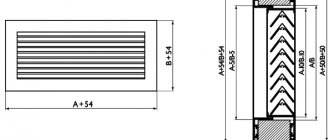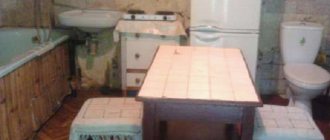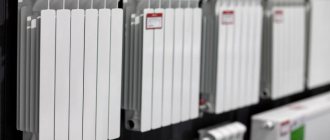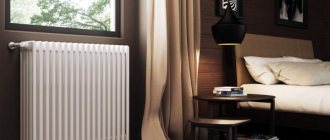In most cases, the bathroom is small in size, but no one will dispute its importance. After all, this is where small children bathe, adults shower and wash, so a prerequisite for using a bathroom is the presence of a comfortable microclimate. In addition, clothes are washed and dried in the bathroom, therefore, for a comfortable stay in the room there must be a source of dry heat. One of the options for solving such problems is a battery in the bathroom.
Answering the question whether a battery is needed in the bathroom, we can say that it will heat the room and speed up the drying process of the laundry, and also prevent the appearance of mold and unpleasant odors. A rather important criterion for choosing a battery for a bathroom is the combination of the functionality of the heating device and its aesthetic appearance.
Main types of heating devices for the bathroom
Everyone knows that the bathroom is a room with a high level of humidity. Therefore, it is necessary to choose a heating device that will function flawlessly in such conditions. For this purpose, you should study in detail the main technical characteristics of different heating devices:
- Cast iron batteries are quite bulky, so they do not have a very attractive appearance. But this factor loses significance, since batteries are characterized by good heat dissipation, long service life and reasonable price. The best option is heating devices made of cast iron with a protective powder coating. It contains particles of polymers and ceramics, thanks to which the surface is covered with a very durable, uniform layer.
- Steel heating appliances can be called not a very good option. The fact is that a humid environment promotes the formation of rust spots, and iron materials lend themselves to this much more easily than others. In addition, the affected areas leak, and during seasonal pressure testing, water flowing under pressure can penetrate weak spots in the radiator.
- Aluminum radiators for the bathroom are considered an ideal option in a house with autonomous heating, as they are lightweight and compact. In addition, it should be taken into account that the central heating system requires the installation of reinforced models due to poor-quality coolant and strong water hammer. It is also worth understanding that connecting to a pipeline made of another metal accelerates the corrosion of aluminum.
- Bimetallic batteries for the bathroom are steel products wrapped in an aluminum jacket. Such a heating device has a service life of about 20 years thanks to special manufacturing technology taking into account all the features of the domestic heating system.
When choosing heating radiators for the bathroom, it is recommended to give preference to devices that can heat the room, dry clothes and at the same time fit perfectly into the overall interior.
How to choose a battery for the bathroom
It is extremely difficult to remove the fungus.
There is no dispute about tastes, so everyone chooses the design of a heated towel rail or radiator for the bathroom for themselves
The first important decision is what the heat output of the heating device should be. If according to the rules, then you need to calculate heat loss
You need to be able to do this, as there are a lot of nuances. It is unlikely that you will be able to make a competent calculation at a glance. To get an accurate value, you need to contact professionals.
The popular method is to select a battery for the bathroom according to the area of the room. Yes, the resulting value will be approximate, but the calculation is not complicated, and most importantly, it works. For every meter you need 100 W of thermal energy (ceilings 2.5 m).
Having found out the required power, decide on the type of heating device:
Naturally, water heating registers include heating registers (battery and water towel). Their advantage is that there are no operating costs. The same cannot be said about electric heated towel rails, but they also have their strengths. This is work all year round without interruptions, a varied design, the ability to control the device remotely via smart sockets
Pay attention to the connections for connecting water towels to the circuit. They can be located on the side or bottom
The distance between them must coincide with the pipes on the risers.
How to adapt a fireplace for heating a dacha is written here.
Electrical equipment for drying clothes
If there is no water heating or hot water in the house, you can install an electric heated towel rail in the bathroom. To operate, it is enough to connect the battery-dryer for the bathroom to an alternating current network. In the tube of the device, made in the form of a snake, a heating element is installed, which heats the coolant.
You should not worry about high energy consumption when using such equipment, since it consumes energy at the same level as incandescent lamps.
It is very important to position electrical equipment correctly in the bathroom: it should not be closer than 0.6 meters to the bathtub, sink or toilet. The plug must have good insulation and an O-ring for the socket. The installation of the battery in the bathroom should be carried out by a professional technician.
When choosing a heater for your bathroom, you don’t need to pay much attention to the aesthetic side, since the device can easily be covered with a decorative screen. It also doesn’t matter what the name of the battery in the bathroom is, the main thing is that it is practical, reliable and effectively heats the room.
Heated towel rail
- an appliance or device whose purpose is to dry towels in the bathroom, heat and dry the bathroom itself.
There are two types of heated towel rails: water and electric. A coolant—hot tap water—circulates inside the water heated towel rail. In urban multi-storey buildings, water heated towel rails are connected to a central hot water supply system. If the house is equipped only with a cold water supply system, then heated towel rails are connected to the heating system.
The hot water riser in multi-storey buildings is arranged as follows: a pipe with hot water from the lower floor enters the apartment (usually in a plumbing closet), here the riser pipe makes a ninety-degree bend and enters the bathroom; in the bathroom, the bottom pipe of the heated towel rail is connected directly to the riser pipe; The top pipe of the heated towel rail is connected to the riser pipe, the riser pipe makes a ninety-degree bend and goes into the apartment on the top floor. It turns out that the air dryer itself in each apartment is a continuation of the riser pipe with hot water, part of it; The diameter of the hot water riser pipe in each multi-storey building is designed to ensure normal water supply in apartments; for this reason, the diameter of the heated towel rail pipe should not be less than the diameter of the hot water riser pipe, otherwise the hot water supply system in the entire multi-storey building will be disrupted.
An additional use of a heated towel rail is to dry small clothes on it: socks, panties, bras, handkerchiefs, etc.
In the USSR, two types of heated towel rails were produced for multi-storey buildings: 1). U-shaped (“kalach”) and 2). M-shaped. Both types of heated towel rails were made from thick-walled galvanized steel pipe. In post-Soviet times, Russia began to produce heated towel rails for multi-storey buildings made of stainless steel. For private homes there is a greater variety of forms of heated towel rails.
Advantages and features of the bottom connection
Similar unit installation schemes have been popular in recent years. Because by securing the heated towel rail from below, you can hide excess pipes with various accessories or interior items. In stores you can find a wide range of models that will be installed in this way. But despite its visual appeal, the bottom connection scheme is less effective than a direct or side connection. And for it to work, it is worth considering a number of points:
- For the installed unit to be effective, the bottom outlet of the riser must be below the edge of the heated towel rail.
- If the upper outlet of the riser with a narrowed or offset bypass is located below the unit, so that it works in any direction of water flow. Even when using straight pipes, a slight lift is required. A strictly horizontal position of the outlet is allowed only when using wide pipes and a short distance from the riser.
- Vertical pipe sections can be of any length. This will allow them to be embedded as close to the floor as possible, regardless of the height of the heated towel rail. Efficiency will not be lost regardless of the direction of water movement in the riser.
- Bends with this connection are also unacceptable, since they provide a place for the formation of air pockets.
- However, if a bottom connection is planned, and the pipe insertion points are so high that the device will be too high to meet all connection conditions, one of the connections can be placed above the bottom edge of the heated towel rail, observing two main conditions. Firstly, the direction of water flow in the riser must be strictly downward. And the upper outlet must be below the edge of the device. Otherwise the system will not work.
- The presence of a thermal insulation layer is mandatory, since they usually try to hide all drainage elements.
In view of the existing conditions, it is worth paying attention to popular heated towel rail connection diagrams. Some of them may be deliberately inoperative due to non-compliance with standards
Therefore, if the master offers you options with inlet bends, a narrowed or offset bypass, be careful. This way you will avoid disappointment when, even if the hot water supply is working properly, the heated towel rail remains cold.
Let's summarize: install or can, not the name of special skills. The easiest option to connect may be a device powered by electrical energy. If you choose a device that operates via a heating system or hot water supply, consider some details. First, find out how often the heating or hot water is turned off in your area. This will determine the time when the heated towel rail is useless. This does not apply to persons living in houses in which water is heated by a water heater or boiler.
Since there are several main options for connecting a heated towel rail to a riser: direct, side, diagonal or bottom, the choice should be made based on the initial position of the device and its height. The easiest to implement is a direct connection.
Several conditions are worth considering when choosing a side or bottom method, especially if an offset bypass or narrowed pipes are used. When choosing one of the latter methods, analyze and refuse options that will obviously not work. And then your heated towel rail will be a beautiful and functional piece of furniture.
Types of heated towel rails [ edit | edit code]
Heated towel rails are divided by type of coolant and size formats.
In the first case, it is determined what type of energy is involved in the formation of heat. In the second case, the design features of the model are determined, in what position it can be connected, depending on the architectural features.
The bathroom should be warm - this is an axiom. In this small but extremely important room for any family, children are bathed, washed, and clothes are washed and dried. To create a comfortable microclimate in the bathroom, you need a source of dry heat. A radiator in the bathroom will not only warm you up and help dry your laundry, but will also help prevent the appearance of mold and unpleasant odors. In this case, it is desirable that the functionality of the device be combined with its aesthetic appearance.
Fountains and saucers in the corners
And yet, you can’t do without humidifying the air: even the best batteries will still dry it out.
There are many ways to do this, and you can often do without special equipment. Thus, indoor plants purify and humidify the air. But don’t think that a small violet can seriously increase the humidity in a large room. These should be large plants with large leaves, and there should be several of them in a large room. Aquariums with fish and indoor fountains and waterfalls can humidify the air. You can also place containers of water in the corners of the rooms. Saucers are best suited for this: from them, water evaporates faster, humidifying the air.
Photo: Shutterstock.com
Types of heating radiators for the bathroom
Not every heating device will work flawlessly in high humidity conditions. To choose the right heating radiators for your bathroom, you need to have an idea of the basic technical characteristics of different types of batteries.
- Cast iron. Batteries look bulky, but they have undeniable advantages - good heat dissipation, long service life and reasonable price. It is optimal if cast iron batteries are powder coated as a protective coating. The composition of this paint includes particles of metal, polymer and ceramics. The dispersion, applied at the factory, envelops the surface of the radiator with a super-strong, uniform layer.
- Steel. Definitely a losing option. Iron rusts faster in a humid environment than other materials. After some time, leaks will begin, and during seasonal pressure testing, serious problems may arise: water under strong pressure will make a hole in the weak point of the radiator.
- Aluminum. A compact and lightweight battery for the bathroom is an ideal solution for a country house with autonomous heating. Only reinforced models can be installed in a centralized network: standard ones cannot withstand water hammer and constant exposure to low-quality coolant. Accelerated corrosion of aluminum may occur if the device is directly connected to a pipeline made of another metal.
- Bimetallic. A steel battery for a bathroom, cast into an aluminum jacket, will last its entire 15-20 years. The developers of bimetallic radiators took into account the features of domestic heating systems.
Advice! Don’t be afraid to block the path of warm air by covering the radiator with a decorative screen. Experience shows that the heat from a closed radiator is quite enough to heat a bathroom.
Having gone through various options, they usually settle on a device that performs several basic functions: heating, drying clothes and matching a specific room design. The wall-mounted radiator in the bathroom meets all these criteria.
Universal insertion method
The coil operates on the principle of a gravity pump. If you insert it correctly, natural circulation and proper operation of the radiator are guaranteed. It is necessary to develop an installation diagram, strictly following the model instructions, and also taking into account the location of the riser in the bathroom.
For most models, the best option for tapping is to supply the coolant through the upper outlets (and the outlet is made from below). This is achieved using universal connections for the battery in the bathroom (photos of examples of work are in our article). This type of insert has a number of advantages:
- the direction and speed of water supply in the riser do not in any way affect the performance of the battery;
- there is no need to bleed air after circulation is turned off.
Another important advantage is the independence of the installation from the location of the riser.
Modifications of wall heaters for the bathroom
Today, a heated floor is often used to heat a bathroom. The solution is reasonable, but where to dry the robes and towels? Not on the floor. Heated towel rails and electric heaters will help solve the dilemma. The devices combine perfectly with a heated floor system - the towels dry quickly and your feet are always warm.
Water heated towel rails
This invention is not new. Every Soviet bathroom had a coil with paint peeling off from dampness. All sorts of small things like socks and handkerchiefs were dried on it. Today, the bent pipe has been replaced by an elegant chrome-plated device that performs the same functions. Such a device is powered from a hot water supply or heating system.
General installation requirements
Installation of a water-based battery is carried out in compliance with the basic requirements:
- The diameter of the dryer tubes should be equal to the diameter of the riser - no narrowing or expansion.
- It is necessary to install a jumper between the heated towel rail outlets.
- Shut-off valves must not be installed on the lintel. This also applies to the section of the pipeline up to the bypass.
- The dryer must be installed at a height of at least 120 centimeters from the floor.
- The distance between the wall and a heated towel rail with a tube diameter of up to 2.5 centimeters should be 3-4 centimeters. With a diameter of more than 2.5 - 6-7 centimeters.
Video: choosing a heated towel rail
Describe your question in as much detail as possible and our expert will answer it
Hello! We have a regular water heated towel rail installed in our apartment, but for some reason it is always cold, or once every few weeks it can get a little warm (perhaps at the peak, when everyone is taking baths). We have a 12-story building, we live on the 2nd floor. Can you please tell me what could be causing the heating problem? Unfortunately, now, the heated towel rail simply serves as a hanger. Perhaps, if the problem still remains unresolved, what is the best way to dismantle it and install an electric heated towel rail? By the way, how safe is an electric heated towel rail in the bathroom, where there is often very high humidity?
Hello Polina Maratovna. Let's look at the situation you described above in more detail and try to find out the reasons for such poor heating with a heated towel rail. The water heated towel rail in your bathroom is most likely made in the shape of a snake and is connected to the central heating pipeline of the house, which is carried out through the main line from the boiler room. There are two probable reasons for such poor functionality of the heated towel rail: – long service life (in most cases, the internal cross-section of the pipe in the heated towel rail narrows over time due to the deposition of various scale salts on the walls due to poor-quality coolant). In this case, the way out of the situation would be to replace the old heated towel rail with a new one; – air lock (it is necessary to check the functionality of the heating system in the whole house for the existence of an air lock in the pipeline, that is, it is necessary to release air from the pipes, if any). If you check the two options described above, you will most likely be able to completely restore the proper operation of the heated towel rail in your bathroom.
Warranty, prices
Prices for radiators depend on their size and power, the material from which they are made, and the finish. A regular one costs from 4,900 rubles, an electric one - from 3,700 rubles.
You will pay about 3,300 rubles for a separate electric radiator. Warranties for electric dryers and heaters range from one to 2 years, although longer periods of up to 8 years are available.
Conclusion
The key to a radiator working properly is its power . This parameter determines the efficiency of the device, which means your comfort when using the bathroom and control of temperature and humidity in this unique room.
What heater power will be optimal? Provided that the room is well insulated, at least 100 W are required for each square meter, regardless of the type of room. However, it should be remembered that in the case of devices made of aluminum or copper, this value must be increased by 20-30%.
Radiators are usually available in several basic colors: white , anthracite, chrome and satin. This non-random selection of neutral colors pairs beautifully with other fittings or ceramics and fits into many shared bathrooms.
When choosing a specific model, keep in mind other devices and decorative elements - although a radiator is primarily a practical device, it can also become a successful decorative element.
Don't forget to take the radiator into account when designing your entire bathroom. Its correct location is as important as the functional layout of the cabin or bath, toilet or washing machine.
Although choosing a model with the ideal shape will not be difficult due to the variety of radiators available in the market, complex installation connections can cause a lot of problems. By considering the presence of a heating device in your bathroom design, you guarantee your comfort and hygiene.
Calculate the required power
The power of a heating device is its most important characteristic. Based on this indicator, you need to buy a heater for a particular room. In order to determine the power, you need to know the area of the room.
Below is a small list with indicators of the area that needs to be heated and the power required for this:
- For 5-6 sq.m. you will need 500 W.
- For 7-9 sq.m. you will need 750 W.
- For 10-12 sq.m. you will need 1000 watts.
- For 12-14 sq.m. you will need 1250 W.
- For 15-17 sq.m. you will need 1500 W.
- For 18-19 sq.m. you will need 1750 W.
- For 20-23 sq.m. you will need 2000 watts.
- For 24-27 sq.m. you will need 2500 W.











